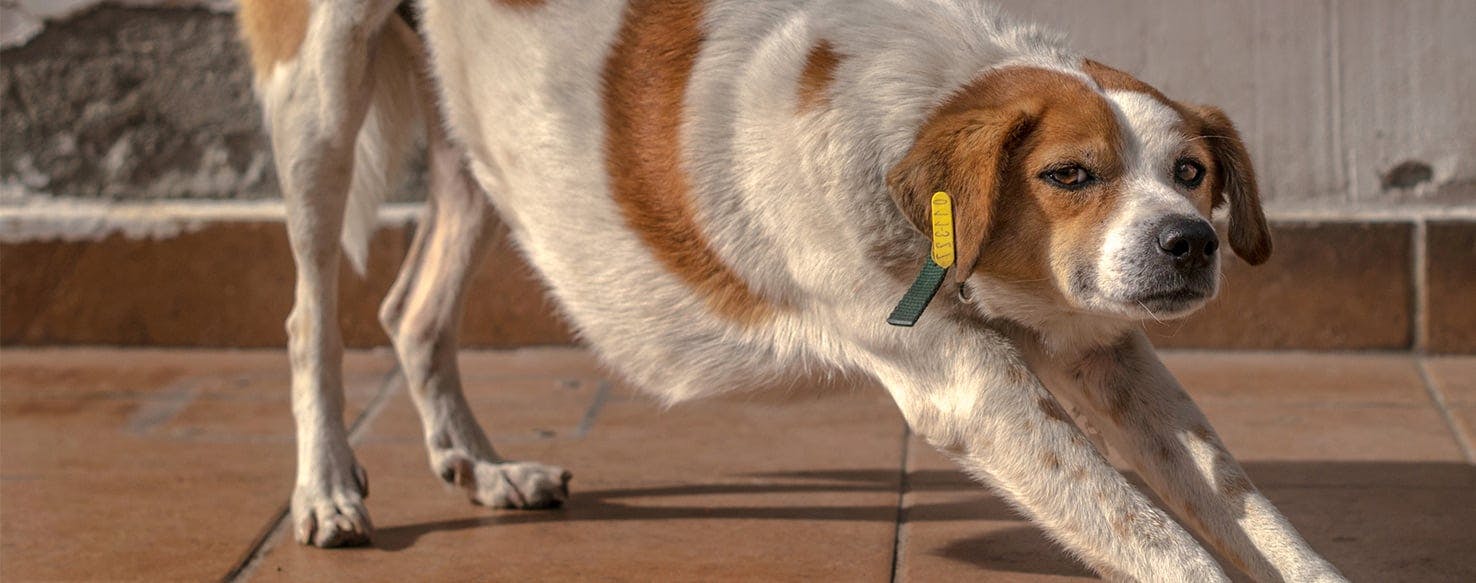- Home
- The Daily Wag!
- Behavior
- Why Do Dogs Stretch
Why Do Dogs Stretch

Common
Normal
Introduction
You do it every morning when you get out of bed…and so does your pooch. Yawn, stretch, and shake is the ritual they abide by each day, much like your yawn, stretch, and coffee routine. Of course, as hunters and fighters, dogs do this following their ancient predecessors and natural instincts. Every dog has their own unique personality and will express their feelings through a variety of motions and signals. Think of your dog’s body as a complete system. In order for all parts to function properly, everything has to be balanced out. Usually, when dogs stretch they do it as part of their instinct, or simply to show their appreciation towards you. Let’s find out more about why dogs stretch and the meaning behind some of their cutest postures.
The Root of the Behavior
You witness it every day when you come home from work or wake up in the morning: your pooch leans backward and stretches his front legs in front of him. This is what they call the greeting stretch, and it’s a posture dogs use towards someone they feel comfortable with. Also known as the greeting bow or the playful bow, this position signals your dog’s invitation to play and communicate with other dogs.
You will clearly recognize the bow by your dog’s most common friendly posture: front legs stretched forward, rear end up in the air, and head up. It’s his cute way of saying hello to you and inviting you to play with him. Sometimes, you can easily mistake your dog’s morning stretch for his playful bow, although they refer to two different situations.
However, if you pay close attention, you will notice that their morning stretch comes along with the idea of preparing their bodies to “roam the territory.” It roots back to their primal instinct of hunting for food or brawling for their territory, as we initially mentioned. The morning stretch is a natural and healthy habit most of us have completely forgotten about.
Remember when you used to wake up in the morning, tighten your arms and legs, yawn, reach your arms above your head, and then reach down to your legs? This unique form of stretching strengthens your dog’s muscular system, particularly the rear extensor muscles, and gets them ready for running. By contracting the muscles first then lengthening them, dogs achieve complete relaxation of the body and activate the connection between their brain and muscles.
Another way you can recognize your dog’s need to stretch is by understanding what sploot means. Have you ever heard about it? If not, think of it as a quirk that is common in all dog breeds (although originally attributed to Corgis), which involves the stretch of one or both legs behind the body. It can sometimes take the form of one leg behind and the other tucked underneath. What does it mean? Splooting allows your pooch to stretch the hips and cool themselves by pressing their belly into the ground or against tile floors.
Need advice about your pet's health?
Get answers fast from a veterinary professional 24/7 in the Wag! App.
Get Vet ChatEncouraging the Behavior
By all means, stretching is something to be encouraged in all dog breeds. Who doesn’t like to see their dogs happy all the time and excited to great them no matter what? Whether it’s the playful bow, the morning stretch, or the relaxing sploot, seeking out ways to increase your dog’s longevity and wellbeing will keep him fit in the long run.
Once you understand your dog's body language, it will be much easier for you to establish a form of communication and protect him from potential harm. You will notice how sociable your dog can be by the way he greets strangers. A lot of dogs have difficulties in showing their confidence around new people, and there are some clear signs that can suggest this to you.
If your pooch’s ears are backward and flat against the head while the back is shrinking to the ground, that is a telltale sign of feeling uncomfortable. You can instruct your friends to hold out their hands while keeping their arm still so that your pooch can learn their scent from a distance. Also, make sure their hand doesn’t go over your dog’s head.
Other Solutions and Considerations
Learn how to discern your dog’s body language and observe him while interacting with other dogs as well. This can tell you the difference between harmless play and the beginning of a fight. Train your dog to socialize and encourage him to build up confidence as he meets new people. You can help by doing a little experiment in your living room: turn sideways and kneel on the ground, keeping your back straight, so that the dog can come to you and sniff.
If you notice concerning behaviors in your pooch such as getting up slowly or resisting going up and down the stairs, pay close attention to their health and mobility. Ask your vet about any peculiar behaviors your dog is experiencing and make sure you follow their advice.
Conclusion
If you want your dog to be healthy, you have to make sure they get the proper care, nutrition and consistent movement to keep them going. Stretching, whether as a way of loosening up or a form of communication, is an important aspect of your dog’s wellbeing. Although owners don’t pay much attention to this common behavior, it’s beneficial for your dog to understand his body language and translate it into actions.
Written by a Shiba Inu lover Patty Oelze
Veterinary reviewed by:
Published: 02/12/2018, edited: 01/30/2020
More articles by Patty Oelze
